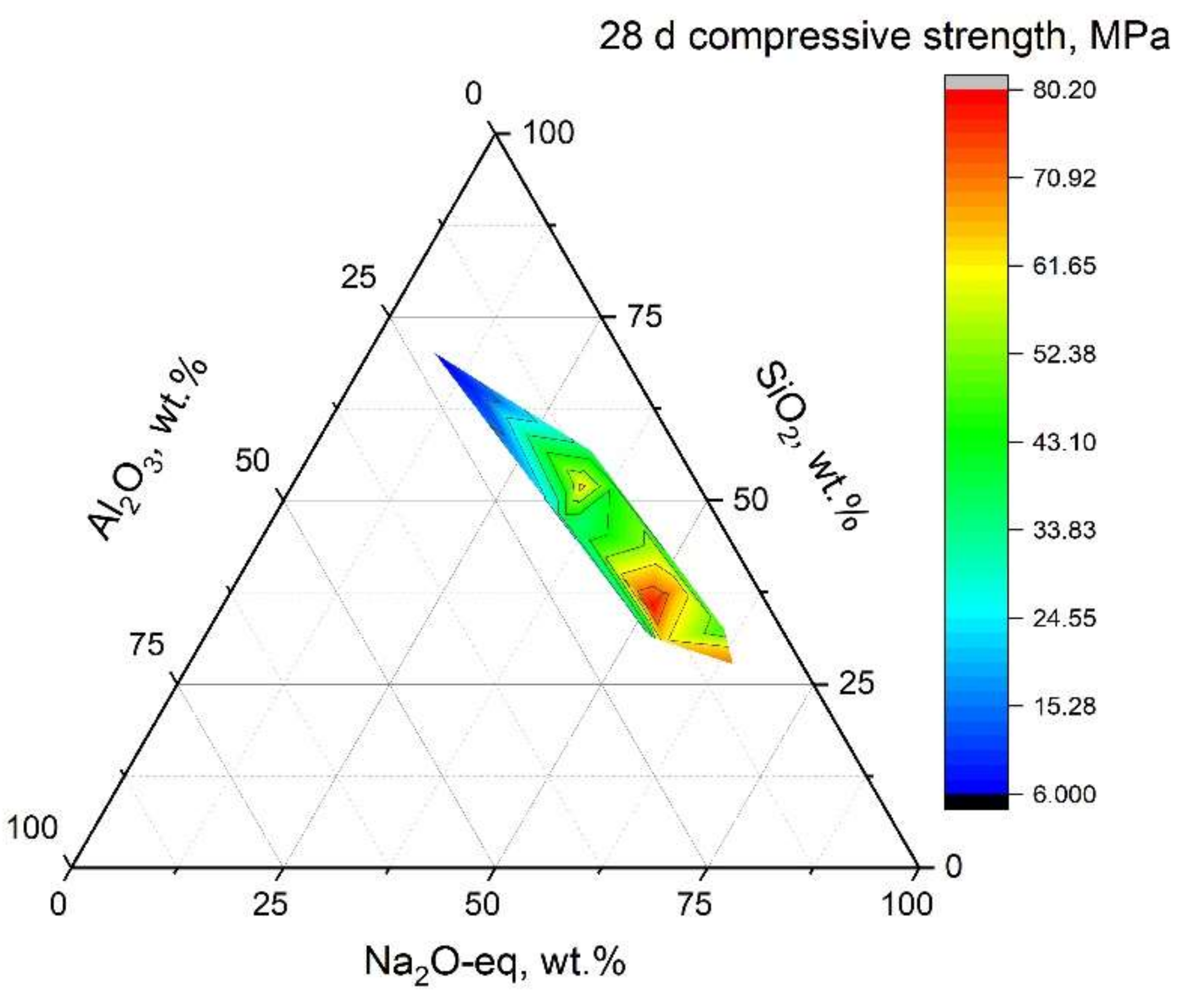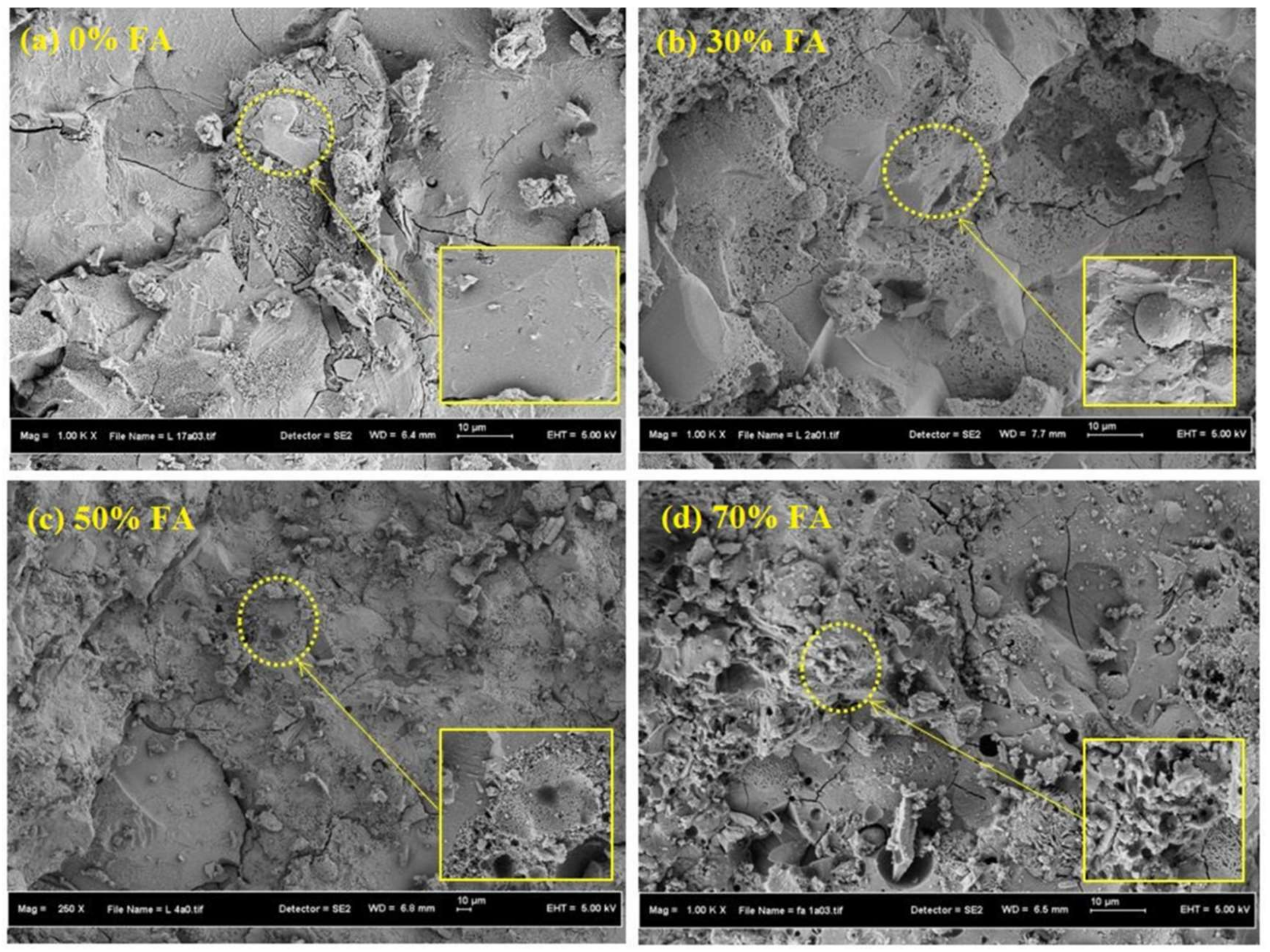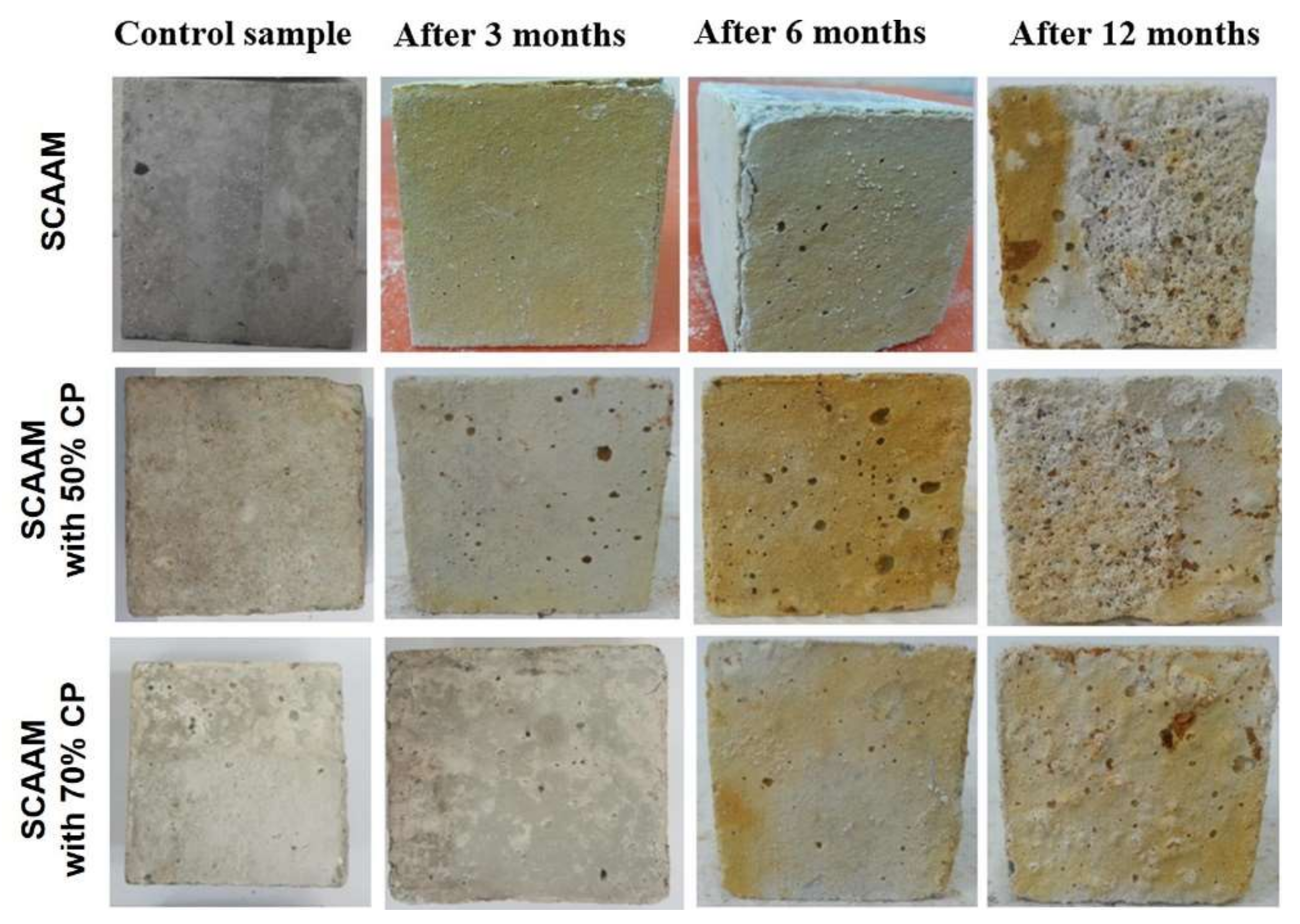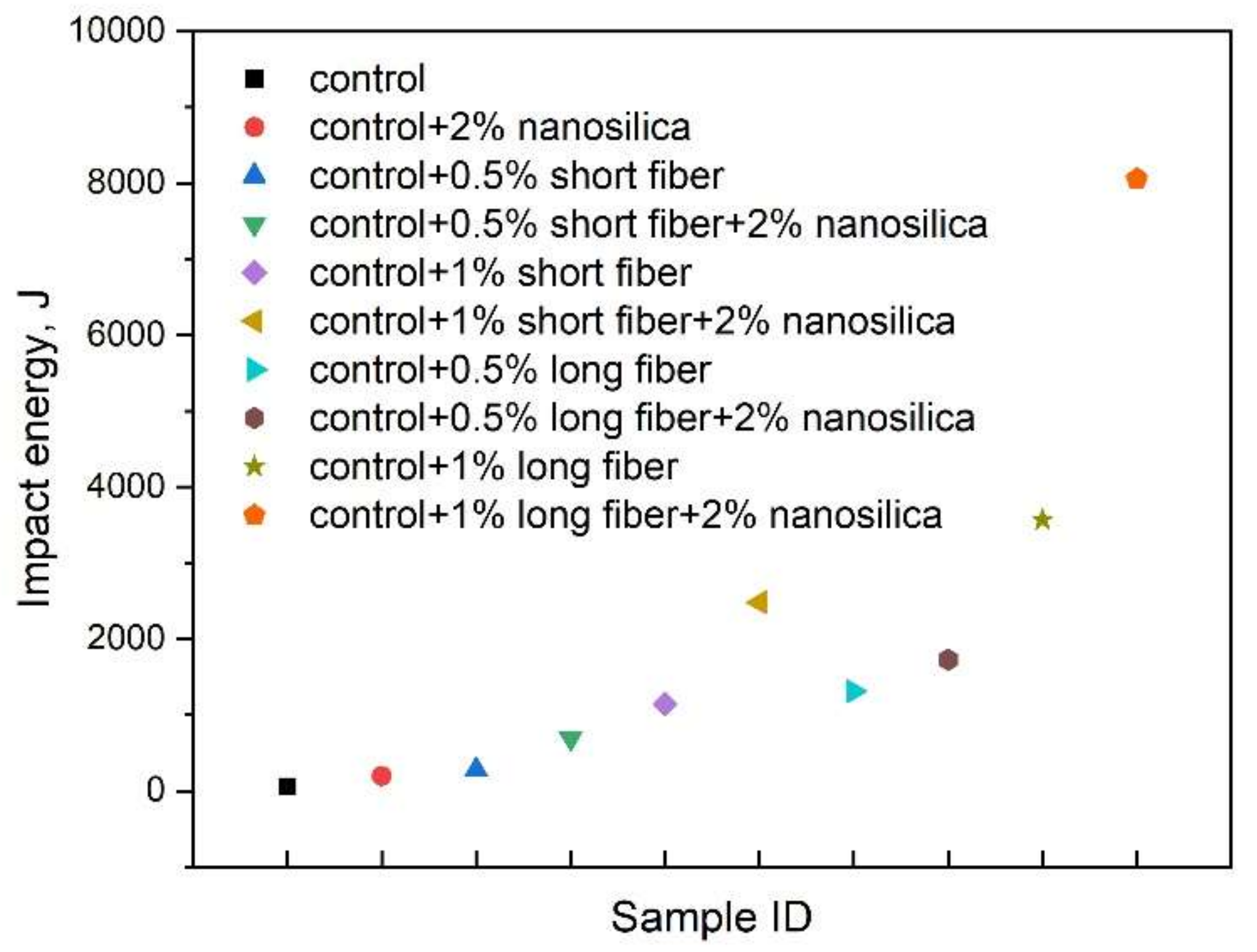Self-Compacting Alkali-Activated Materials: Progress and Perspectives
Abstract
:1. Introduction
2. Materials and Formulations
2.1. New Precursors
2.1.1. Rice Husk Ash
2.1.2. Nano Silica
2.1.3. Ceramic Powder
2.1.4. Wollastonite
2.1.5. Water Treatment Sludge
2.2. Formulations of SCAAMs
3. Property of Fresh SCAAMs
4. Property of Hardened SCAAMs
4.1. Compressive Strength
4.2. Microstructure
4.3. Water Absorption
4.4. Acid and Sulfate Resistance
5. Other Properties
5.1. Impact Resistance
5.2. Interface Shear Strength
6. Challenges and Perspectives
7. Conclusions
Author Contributions
Funding
Institutional Review Board Statement
Informed Consent Statement
Data Availability Statement
Conflicts of Interest
References
- Shi, C.; Wu, Z.; Lv, K.; Wu, L. A review on mixture design methods for self-compacting concrete. Constr. Build. Mater. 2015, 84, 387–398. [Google Scholar] [CrossRef]
- Sonebi, M.; Yahia, A. Mix design procedure, tests, and standards. In Self-Compacting Concrete: Materials, Properties and Applications; Siddique, R., Ed.; Woodhead Publishing: Cambridgeshire, UK, 2020; pp. 1–30. [Google Scholar]
- Okamura, H. Self-compacting high-performance concrete. Concr. Int. 1997, 19, 50–54. [Google Scholar]
- Ozawa, K.; Maekawa, K.; Kunishima, M.; Okamura, H. Development of high performance concrete based on the durability design of concrete structures. Proc. Second East Asia-Pac. Conf. Struct. Eng. Constr. 1989, 1, 445–450. [Google Scholar]
- Rasekh, H.; Joshaghani, A.; Jahandari, S.; Aslani, F.; Ghodrat, M. Rheology and workability of SCC. In Self-Compacting Concrete: Materials, Properties and Applications; Siddique, R., Ed.; Woodhead Publishing: Cambridgeshire, UK, 2020; pp. 31–63. [Google Scholar]
- Kashani, A.; Ngo, T. Production and placement of self-compacting concrete. In Self-Compacting Concrete: Materials, Properties and Applications; Siddique, R., Ed.; Woodhead Publishing: Cambridgeshire, UK, 2020; pp. 65–81. [Google Scholar]
- Caijun, S.; Yanzhong, W. Mixture Proportioning and Properties of Self-Consolidating Lightweight Concrete Containing Glass Powder. ACI Mater. J. 2005, 102, 355–363. [Google Scholar]
- Proceedings pro042: 1st International Symposium on Design, Performance and Use of Self-Consolidating Concrete (SCC’2005-China). Available online: https://www.rilem.net (accessed on 28 October 2021).
- Huseien, G.F.; Sam, A.R.M.; Shah, K.W.; Mirza, J. Effects of ceramic tile powder waste on properties of self-compacted alkali-activated concrete. Constr. Build. Mater. 2020, 236, 117574. [Google Scholar] [CrossRef]
- Goodier, C.I. Development of self-compacting concrete. Proc. Inst. Civ. Eng.-Struct. Build. 2003, 156, 4. [Google Scholar] [CrossRef]
- EFNARC. Specification and Guidelines for Self-Compacting Concrete. 2002. Available online: https://efnarc.org/ (accessed on 28 October 2021).
- Huseien, G.F.; Mirza, J.; Ismail, M.; Ghoshal, S.K.; Hussein, A.A. Geopolymer mortars as sustainable repair material: A comprehensive review. Renew. Sustain. Energy Rev. 2017, 80, 54–74. [Google Scholar] [CrossRef]
- Garcia-Lodeiro, I.; Palomo, A.; Fernández-Jiménez, A.; MacPhee, D.E. Compatibility studies between N-A-S-H and C-A-S-H gels. Study in the ternary diagram Na2O-CaO-Al2O3-SiO2-H2O. Cem. Concr. Res. 2011, 41, 923–931. [Google Scholar] [CrossRef]
- Abdel-Gawwad, H.A.; Heikal, E.; El-Didamony, H.; Hashim, F.S.; Mohammed, A.H. Recycling of concrete waste to produce ready-mix alkali activated cement. Ceram. Int. 2018, 44, 7300–7304. [Google Scholar] [CrossRef]
- Huseien, G.F.; Shah, K.W.; Sam, A.R.M. Sustainability of nanomaterials based self-healing concrete: An all-inclusive insight. J. Build. Eng. 2019, 23, 155–171. [Google Scholar] [CrossRef]
- Huseien, G.F.; Mirza, J.; Ariffin, N.F.; Hussin, M.W. Synthesis and characterization of self-healing mortar with modified strength. J. Teknol. 2015, 76, 195–200. [Google Scholar] [CrossRef] [Green Version]
- Provis, J.L.; Bernal, S.A. Geopolymers and Related Alkali-Activated Materials. Annu. Rev. Mater. Res. 2014, 44, 299–327. [Google Scholar] [CrossRef]
- Provis, J.L.; van Deventer, J.S.J. Alkali Activated Materials, 1st ed.; Springer: Dordrecht, The Netherlands, 2014. [Google Scholar]
- Shi, C.; Roy, D.; Krivenko, P. Alkali-Activated Cements and Concretes; CRC Press: London, UK, 2003. [Google Scholar]
- 70,000 Tonnes Geopolymer Concrete for Airport. Available online: https://www.geopolymer.org/news/70000-tonnes-geopolymer-concrete-airport (accessed on 28 October 2021).
- Ahmed, M.F.; Nuruddin, M.F.; Shafiq, N. Compressive Strength and Workability Characteristics of Low-Calcium Fly ash-based Self-Compacting Geopolymer Concrete. Int. J. Civ. Environ. Eng. 2011, 2, 64–70. [Google Scholar]
- Memon, F.A.; Nuruddin, M.; Demie, S.; Shafiq, N. Effect of curing conditions on strength of fly ash-based self-compacting geopolymer concrete. J. Civ. Environ. Eng. 2011, 5, 342–345. [Google Scholar]
- Nuruddin, M.F.; Demie, S.; Ahmed, M.F.; Shafiq, N. Effect of superplasticizer and NaOH molarity on workability, compressive strength and microstructure properties of self-compacting geopolymer concrete. Int. J. Civ. Environ. Eng. 2011, 3, 812–820. [Google Scholar]
- Henigal, A.M.; Sherif, M.A.; Hassan, H. Study on properties of self-compacting geopolymer concrete. IOSR-JMCE 2017, 14, 52–66. [Google Scholar] [CrossRef]
- Memon, F.A.; Nuruddin, M.F.; Khan, S.; Shafiq, N.; Ayub, T. Effect of sodium hydroxide concentration on fresh properties and compressive strength of self-compacting geopolymer concrete. J. Eng. Sci. Technol. 2013, 8, 44–56. [Google Scholar]
- Manjunath, R.; Narasimhan, M.C.; Umesh, K.M.; Shivam, K.; Bharathi, U.K.B. Studies on development of high performance, self-compacting alkali activated slag concrete mixes using industrial wastes. Constr. Build. Mater. 2019, 198, 133–147. [Google Scholar] [CrossRef]
- Manjunath, R.; Narasimhan, M.C. An experimental investigation on self-compacting alkali activated slag concrete mixes. J. Build. Eng. 2018, 17, 1–12. [Google Scholar] [CrossRef]
- Patel, Y.J.; Shah, N. Enhancement of the properties of ground granulated blast furnace slag based self-compacting geopolymer concrete by incorporating rice husk ash. Constr. Build. Mater. 2018, 171, 654–662. [Google Scholar] [CrossRef]
- Vishnu, N.; Kolli, R.; Ravella, D.P. Studies on self-compacting geopolymer concrete containing flyash, GGBS, wollastonite and graphene oxide. Mater. Today Proc. 2021, 43, 2422–2427. [Google Scholar] [CrossRef]
- Gülşan, M.E.; Alzeebaree, R.; Rasheed, A.A.; Nis, A.; Kurtoglu, A.E. Development of fly ash/slag based self-compacting geopolymer concrete using nano-silica and steel fiber. Constr. Build. Mater. 2019, 211, 271–283. [Google Scholar]
- Sun, Z.; Vollpracht, A. Isothermal calorimetry and in-situ XRD study of the NaOH activated fly ash, metakaolin and slag. Cem. Concr. Res. 2018, 103, 110–122. [Google Scholar] [CrossRef]
- Provis, J.L.; Palomo, A.; Shi, C. Advances in understanding alkali-activated materials. Cem. Concr. Res. 2015, 78, 110–125. [Google Scholar] [CrossRef]
- Turmanova, S.; Genieva, S.; Vlaev, L. Obtaining some polymer composites filled with rice husks ash—A review. Int. J. Chem. 2012, 4, 62–89. [Google Scholar] [CrossRef] [Green Version]
- Pode, R. Potential applications of rice husk ash waste from rice husk biomass power plant. Renew. Sustain. Energy Rev. 2016, 53, 1468–1485. [Google Scholar] [CrossRef]
- Raman, S.N.; Ngo, T.; Mendis, P.; Mahmud, H.B. High-strength rice husk ash concrete incorporating quarry dust as a partial substitute for sand. Constr. Build. Mater. 2011, 25, 3123–3130. [Google Scholar] [CrossRef]
- Kishore, G.N.; Gayathri, B. Experimental study on rise husk ash and fly ash based geopolymer concrete using sand. IOP Conf. Ser. Mater. Sci. Eng. 2017, 225, 012273. [Google Scholar] [CrossRef] [Green Version]
- Van, V.-T.-A.; Rößler, C.; Bui, D.-D.; Ludwig, H.-M. Rice husk ash as both pozzolanic admixture and internal curing agent in ultra-high performance concrete. Cem. Concr. Compos. 2014, 53, 270–278. [Google Scholar] [CrossRef]
- Detphan, S.; Chindaprasirt, P. Preparation of fly ash and rice husk ash geopolymer. Int. J. Miner. Metall. Mater. 2009, 16, 720–726. [Google Scholar]
- Fletcher, R.A.; MacKenzie, K.J.D.; Nicholson, C.L.; Shimada, S. The composition range of aluminosilicate geopolymers. J. Eur. Ceram. Soc. 2005, 25, 1471–1477. [Google Scholar] [CrossRef]
- Van Tuan, N.; Ye, G.; van Breugel, K.; Copuroglu, O. Hydration and microstructure of ultra high performance concrete incorporating rice husk ash. Cem. Concr. Res. 2011, 41, 1104–1111. [Google Scholar] [CrossRef]
- Sturn, P.; Gluth, G.J.G.; Brouwers, H.J.H.; Kuhne, H.C. Synthesizing one-part geopolymers from rice husk ash. Cem. Concr. Compos 2017, 37, 108–118. [Google Scholar]
- Kim, Y.Y.; Lee, B.-J.; Saraswathy, V.; Kwon, S.-J. Strength and durability performance of alkali-activated rice husk ash geopolymer mortar. Sci. World J. 2014, 2014, 209584. [Google Scholar] [CrossRef] [PubMed]
- Rattanasak, U.; Chindaprasirt, P.; Suwanvitaya, P. Development of high volume rice husk ash alumino silicate composites. Int. J. Miner. Metall. Mater. 2010, 17, 654–659. [Google Scholar] [CrossRef]
- He, J.; Jie, Y.; Zhang, J.; Yu, Y.; Zhang, G. Synthesis and characterization of red mud and rice husk ash-based geopolymer composites. Cem. Concr. Compos. 2013, 37, 108–118. [Google Scholar] [CrossRef]
- Kusbiantoro, A.; Nuruddin, M.F.; Shafiq, N.; Qazi, S.A. The effect of microwave incinerated rice husk ash on the compressive and bond strength of fly ash based geopolymer concrete. Constr. Build. Mater. 2012, 36, 695–703. [Google Scholar] [CrossRef]
- Ardiantoro, D.; Sunarsih, E.S.; Sucipto, T.L.A. The role of rice husk ash in enhancing the fresh properties, density, and compressive strength of fly ash based self-compacting geopolymer concrete. J. Phys. Conf. Ser. 2021, 1808, 012014. [Google Scholar] [CrossRef]
- Buyuknalcaci, F.N.; Polat, Y.; Negawo, T.A.; Döner, E.; Alam, M.S.; Hamouda, T.; Kilic, A. 24-Carbon nanotube-based nanocomposites for wind turbine applications. In Polymer-Based Nanocomposites for Energy and Environmental Applications; Jawaid, M., Khan, M.M., Eds.; Woodhead Publishing: Cambridgeshire, UK, 2018; pp. 635–661. [Google Scholar]
- Shih, J.Y.; Chang, T.P.; Hsiao, T.C. Effect of nanosilica on characterization of Portland cement composite. Mater. Sci. Eng. A 2006, 424, 266–274. [Google Scholar] [CrossRef]
- Zhang, M.H.; Li, H. Pore structure and chloride permeability of concrete containing nano-particles for pavement. Constr. Build. Mater. 2011, 25, 608–616. [Google Scholar] [CrossRef]
- Said, A.M.; Zeidan, M.S.; Bassuoni, M.T.; Tian, Y. Properties of concrete incorporating nano-silica. Constr. Build. Mater. 2012, 36, 838–844. [Google Scholar] [CrossRef]
- Pacheco-Torgal, F.; Miraldo, S.; Ding, Y.; Labrincha, J.A. Targeting HPC with the help of nanoparticles: An overview. Constr. Build. Mater. 2013, 38, 365–370. [Google Scholar] [CrossRef] [Green Version]
- Shaikh, F.U.A.; Supit, S.W.M.; Sarker, P.K. A study on the effect of nano silica on compressive strength of high volume fly ash mortars and concretes. Mater. Des. 2014, 60, 433–442. [Google Scholar] [CrossRef]
- Gao, K.; Lin, K.L.; Wang, D.; Hwang, C.L.; Anh Tuan, B.L.; Shiu, H.S.; Cheng, T.W. Effect of nano-SiO2 on the alkali-activated characteristics of metakaolin-based geopolymers. Constr. Build. Mater. 2013, 48, 441–447. [Google Scholar] [CrossRef]
- Adak, D.; Sarkar, M.; Mandal, S. Effect of nano-silica on strength and durability of fly ash based geopolymer mortar. Constr. Build. Mater. 2014, 70, 453–459. [Google Scholar] [CrossRef]
- Wild, S.; Khatib, J.M.; O’Farrell, M. Sulphate resistance of mortar, containing ground brick clay calcined at different temperatures. Cem. Concr. Res. 1997, 27, 697–709. [Google Scholar] [CrossRef]
- Turanli, L.; Bektas, F.; Monteiro, P.J.M. Use of ground clay brick as a pozzolanic material to reduce the alkali-silica reaction. Cem. Concr. Res. 2003, 33, 1539–1542. [Google Scholar] [CrossRef]
- Toledo Filho, R.D.; Gonçalves, J.P.; Americano, B.B.; Fairbairn, E.M.R. Potential for use of crushed waste calcined-clay brick as a supplementary cementitious material in Brazil. Cem. Concr. Res. 2007, 37, 1357–1365. [Google Scholar] [CrossRef]
- Gonçalves, J.P.; Tavares, L.M.; Toledo Filho, R.D.; Fairbairn, E.M.R. Performance evaluation of cement mortars modified with metakaolin or ground brick. Constr. Build. Mater. 2009, 23, 1971–1979. [Google Scholar] [CrossRef]
- Sánchez De Rojas, M.I.; Marín, F.P.; Frías, M.; Rivera, J. Properties and performances of concrete tiles containing waste fired clay materials. J. Am. Ceram. Soc. 2007, 90, 3559–3565. [Google Scholar] [CrossRef]
- Sun, Z.; Cui, H.; An, H.; Tao, D.; Xu, Y.; Zhai, J.; Li, Q. Synthesis and thermal behavior of geopolymer-type material from waste ceramic. Constr. Build. Mater. 2013, 49, 281–287. [Google Scholar] [CrossRef]
- Tolinski, M. Overview of Fillers and Fibers. In Additives for Polyolefins; Tolinski, M., Ed.; William Andrew Publishing: Norwich, NY, USA, 2009; pp. 93–119. [Google Scholar]
- Murphy, J. Modifying Specific Properties: Mechanical Properties–Fillers. In Additives for Plastics Handbook, 2nd ed.; Elsevier Science: Amsterdam, The Netherlands, 2001; pp. 19–35. [Google Scholar]
- Ransinchung, R.N.G.D.; Kumar, B. Investigations on pastes and mortars of ordinary Portland cement admixed with wollastonite and microsilica. J. Mater. Civ. Eng. 2010, 22, 305–313. [Google Scholar] [CrossRef]
- Thomas, B.S.; Gupta, R.C.; Kalla, P.; Cseteneyi, L. Strength, abrasion and permeation characteristics of cement concrete containing discarded rubber fine aggregates. Constr. Build. Mater. 2014, 59, 204–212. [Google Scholar] [CrossRef]
- Archez, J.; Texier-Mandoki, N.; Bourbon, X.; Caron, J.F.; Rossignol, S. Influence of the wollastonite and glass fibers on geopolymer composites workability and mechanical properties. Constr. Build. Mater. 2020, 257, 119511. [Google Scholar] [CrossRef]
- Mañosa, J.; Cerezo-Piñas, M.; Maldonado-Alameda, A.; Formosa, J.; Giro-Paloma, J.; Rosell, J.R.; Chimenos, J.M. Water treatment sludge as precursor in non-dehydroxylated kaolin-based alkali-activated cements. Appl. Clay Sci. 2021, 204, 106032. [Google Scholar] [CrossRef]
- Godoy, L.; Rohden, A.B.; Garcez, M.R.; Costa, E.B.; Dalt, S.; Andrade, J. Valorization of water treatment sludge waste by application as supplementary cementitious material. Constr. Build. Mater. 2019, 223, 939–950. [Google Scholar] [CrossRef]
- Cremades, L.V.; Cusidó, J.A.; Arteaga, F. Recycling of sludge from drinking water treatment as ceramic material for the manufacture of tiles. J. Clean. Prod. 2018, 201, 1071–1080. [Google Scholar] [CrossRef]
- Guo, X.; Shi, H.; Dick, W. Use of heat-treated water treatment residuals in fly ash-based geopolymers. J. Am. Ceram. Soc. 2010, 93, 272–278. [Google Scholar] [CrossRef]
- Nimwinya, E.; Arjharn, W.; Horpibulsuk, S.; Phoo-ngernkham, T.; Poowancum, A. A sustainable calcined water treatment sludge and rice husk ash geopolymer. J. Clean. Prod. 2016, 119, 128–134. [Google Scholar] [CrossRef]
- Waijarean, N.; Asavapisit, S.; Sombatsompop, K. Strength and microstructure of water treatment residue-based geopolymers containing heavy metals. Constr. Build. Mater. 2014, 50, 486–491. [Google Scholar] [CrossRef]
- Geraldo, R.H.; Fernandes, L.F.R.; Camarini, G. Water treatment sludge and rice husk ash to sustainable geopolymer production. J. Clean. Prod. 2017, 149, 146–155. [Google Scholar] [CrossRef]
- Horpibulsuk, S.; Suksiripattanapong, C.; Samingthong, W.; Rachan, R.; Arulrajah, A. Durability against wetting–drying cycles of water treatment sludge–fly ash geopolymer and water treatment sludge–cement and silty clay–cement Systems. J. Mater. Civ. Eng. 2016, 28, 04015078. [Google Scholar] [CrossRef]
- Suksiripattanapong, C.; Horpibulsuk, S.; Boongrasan, S.; Udomchai, A.; Chinkulkijniwat, A.; Arulrajah, A. Unit weight, strength and microstructure of a water treatment sludge–fly ash lightweight cellular geopolymer. Constr. Build. Mater. 2015, 94, 807–816. [Google Scholar] [CrossRef]
- Hwang, C.; Chiang, C.; Huynh, T.; Vo, D.; Jhang, B.; Ngo, S. Properties of alkali-activated controlled low-strength material produced with waste water treatment sludge, fly ash, and slag. Constr. Build. Mater. 2017, 135, 459–471. [Google Scholar] [CrossRef]
- Luukkonen, T.; Abdollahnejad, Z.; Yliniemi, J.; Kinnunen, P.; Illikainen, M. One-part alkali-activated materials: A review. Cem. Concr. Res. 2018, 103, 21–34. [Google Scholar] [CrossRef]
- Nematollahi, B.; Sanjayan, J. Effect of Superplasticizers on workability of fly ash based geopolymer; Springer: Tanjong Pagar, Singapore, 2014; pp. 713–719. [Google Scholar]
- Memon, F.A.; Nuruddin, M.F.; Demie, S.; Shafiq, N. Effect of superplasticizer and extra water on workability and compressive strength of self-compacting geopolymer concrete. Res. J. Appl. Sci. Eng. Technol. 2012, 4, 407–414. [Google Scholar]
- Carabba, L.; Manzi, S.; Bignozzi, M.C. Superplasticizer addition to carbon fly ash geopolymers activated at room temperature. Materials 2016, 9, 9070586. [Google Scholar] [CrossRef] [Green Version]
- Dener, M.; Karatas, M.; Mohabbi, M. High temperature resistance of self-compacting alkali activated slag/portland cement composite using lightweight aggregate. Constr. Build. Mater. 2021, 290, 123250. [Google Scholar] [CrossRef]
- Nagaraj, V.K.; Venkatesh Babu, D.L. Formulation and performance evaluation of alkali-activated self-compacting concrete. Asian J. Civ. Eng. 2018, 19, 1021–1036. [Google Scholar] [CrossRef]
- Huseien, G.F.; Sam, A.R.M.; Alyousef, R. Texture, morphology and strength performance of self-compacting alkali-activated concrete: Role of fly ash as GBFS replacement. Constr. Build. Mater. 2021, 270, 121368. [Google Scholar] [CrossRef]
- Muttashar, H.L.; Ariffin, M.A.M.; Hussin, M.W.; Ishaq, S.B. Realisation of enhanced self-compacting geopolymer concrete using spent garnet as sand replacement. Mag. Concr. Res. 2018, 70, 558–569. [Google Scholar] [CrossRef]
- Rahman, S.K.; Al-Ameri, R. A newly developed self-compacting geopolymer concrete under ambient condition. Constr. Build. Mater. 2021, 267, 121822. [Google Scholar] [CrossRef]
- Australia Standard. Methods of Testing Concrete Determination of Properties Related to the Consistency of Concrete-Slump Flow T and J-Ring Test. Available online: https://infostore.saiglobal.com (accessed on 28 October 2021).
- K, N.V.; Babu, D.L.V. Assessing the performance of molarity and alkaline activator ratio on engineering properties of self-compacting alkaline activated concrete at ambient temperature. J. Build. Eng. 2018, 20, 137–155. [Google Scholar] [CrossRef]
- Saini, G.; Vattipalli, U. Assessing properties of alkali activated GGBS based self-compacting geopolymer concrete using nano-silica. Case Stud. Constr. Mater. 2020, 12, 00352. [Google Scholar] [CrossRef]
- Adesina, A. Performance and sustainability overview of alkali-activated self-compacting concrete. Waste Dispos. Sustain. Energy 2020, 2, 165–175. [Google Scholar] [CrossRef]
- Huseien, G.F.; Shah, K.W. Durability and life cycle evaluation of self-compacting concrete containing fly ash as GBFS replacement with alkali activation. Constr. Build. Mater. 2020, 235, 117458. [Google Scholar] [CrossRef]
- Škvára, F.; Kopecký, L.; Šmilauer, V.; Bittnar, Z. Material and structural characterization of alkali activated low-calcium brown coal fly ash. J. Hazard. Mater. 2009, 168, 711–720. [Google Scholar] [CrossRef] [PubMed]
- Fernandez-Jimenez, A.; Puertas, F.; Arteaga, A. Determination of kinetic equations of alkaline activation of blast furnace slag by means of calorimetric data. J. Therm. Anal. Calorim. 1998, 52, 945–955. [Google Scholar] [CrossRef]
- Nuruddin, M.F.; Demie, S.; Shafiq, N. Effect of mix composition on workability and compressive strength of self-compacting geopolymer concrete. Can. J. Civ. Eng. 2011, 38, 1196–1203. [Google Scholar] [CrossRef]
- Sun, Z.; Vollpracht, A. One year geopolymerisation of sodium silicate activated fly ash and metakaolin geopolymers. Cem. Concr. Compos. 2019, 95, 98–110. [Google Scholar] [CrossRef]
- Xu, H.; Van Deventer, J.S.J. The geopolymerisation of alumino-silicate minerals. Int. J. Min. Process 2000, 59, 247–266. [Google Scholar] [CrossRef] [Green Version]
- Davidovits, J. Chemistry of geopolymeric systems, terminology. In Proceedings of the 2nd International Conference on Geopolymer 99, Saint Qunentin, France, 1–2 July 1999; pp. 9–39. [Google Scholar]
- Duxson, P.; Provis, J.L.; Lukey, G.C.; Mallicoat, S.W.; Kriven, W.M.; van Deventer, J.S.J. Understanding the relationship between geopolymer composition, microstructure and mechanical properties. Colloids Surf. A Physicochem. Eng. Asp. 2005, 269, 47–58. [Google Scholar] [CrossRef]
- Fernández-Jiménez, A.; Palomo, A.; Sobrados, I.; Sanz, J. The role played by the reactive alumina content in the alkaline activation of fly ashes. Microporous Mesoporous Mater. 2006, 91, 111–119. [Google Scholar] [CrossRef]
- Lee, N.K.; Jang, J.G.; Lee, H.K. Shrinkage characteristics of alkali-activated fly ash/slag paste and mortar at early ages. Cem. Concr. Compos. 2014, 53, 239–248. [Google Scholar] [CrossRef]
- Wardhono, A.; Gunasekara, C.; Law, D.W.; Setunge, S. Comparison of long term performance between alkali activated slag and fly ash geopolymer concretes. Constr. Build. Mater. 2017, 143, 272–279. [Google Scholar] [CrossRef]
- Fernández-Jiménez, A.; Palomo, A.; Criado, M. Microstructure development of alkali-activated fly ash cement: A descriptive model. Cem. Concr. Res. 2005, 35, 1204–1209. [Google Scholar] [CrossRef]
- Niş, A.; Eren, N.A.; Çevik, A. Effects of nanosilica and steel fibers on the impact resistance of slag based self-compacting alkali-activated concrete. Ceram. Int. 2021, 47, 23905–23918. [Google Scholar] [CrossRef]
- Mohamed, O. A review of durability and strength characteristics of alkali-activated slag concrete. Materials 2019, 12, 1198. [Google Scholar] [CrossRef] [Green Version]
- Ganesan, N.; Abraham, R.; Deepa Raj, S. Durability characteristics of steel fibre reinforced geopolymer concrete. Constr. Build. Mater. 2015, 93, 471–476. [Google Scholar] [CrossRef]
- Falah, M.; Obenaus-Emler, R.; Kinnunen, P.; Illikainen, M. Effects of activator properties and curing conditions on alkali-activation of low-alumina mine tailings. Waste Biomass Valorization 2020, 11, 5027–5039. [Google Scholar] [CrossRef] [Green Version]
- Zhang, W.; Yao, X.; Yang, T.; Zhang, Z. The degradation mechanisms of alkali-activated fly ash/slag blend cements exposed to sulphuric acid. Constr. Build. Mater. 2018, 186, 1177–1187. [Google Scholar] [CrossRef]
- Yıldırım, G.; Khiavi, F.E.; Anıl, Ö.; Şahin, O.; Şahmaran, M.; Erdem, R.T. Performance of engineered cementitious composites under drop-weight impact: Effect of different mixture parameters. Struct. Concr. 2020, 21, 1051–1070. [Google Scholar] [CrossRef]
- Mohammadi, Y.; Carkon-Azad, R.; Singh, S.P.; Kaushik, S.K. Impact resistance of steel fibrous concrete containing fibres of mixed aspect ratio. Constr. Build. Mater. 2009, 23, 183–189. [Google Scholar] [CrossRef]
- Ismail, S.; Ramli, M. Impact resistance of recycled aggregate concrete with single and hybrid fibers. MATEC Web Conf. 2016, 47, 02001. [Google Scholar] [CrossRef] [Green Version]
- Ganeshan, M.; Venkataraman, S. Interface shear strength evaluation of self-compacting geopolymer concrete using push-off test. J. King Saud Univ. Eng. Sci. 2020, 8, 1–10. [Google Scholar] [CrossRef]






| Reference | Precursor | Activator | Fine Aggregate | Coarse Aggregate | Slump Flow | V-Funnel | L-Box | J-Ring | ||
|---|---|---|---|---|---|---|---|---|---|---|
| Spreading (mm) | T50(s) | (s) | H2/H1 | (mm) | Difference | |||||
| [9] | Mixture of GGBS and ceramic tile powder, 484 kg/m3 | Mixture of NaOH and sodium silicate solution, activator to solid precursor ratio of 0.5 | River sand, 844 kg/m3 | Crushed granite, 756 kg/m3 | 560–748.4 | 3.0–6.0 | 7.5–14.0 | 0.78–0.95 | - | 6.0–12.0 |
| [26] | Mixture of GGBS with quartz powder, 700–800 kg/m3 | Mixtures of sodium silicate with NaOH, solution to precursor ratio 0.4–0.44 | Mixture of steel slag sand and quartz sand, 573–728 kg/m3 | Electric arc furnace slag, 387–490 kg/m3 | 700–800 | 4–5 | 8.5–10.4 | 0.88–0.95 | 693–795 | 7.8–9.7 |
| [27] | GGBS, 700–900 kg/m3 | Mixtures of NaOH and sodium silicate solutions, water to binder ratio of 0.47, 0.475 and 0.48 | Slag sand, 303–636 kg/m3 | Electric arc furnace slag, 228–480 kg/m3 | 685–720 | 3.7–4.8 | 8.5–11.0 | 0.86–0.96 | 670–717 | 5.0–7.0 |
| [30] | Mixture of GGBS and FA, 450 kg/m3 | Sodium silicate and sodium hydroxide solutions, activator to precursor 0.5 | Crushed limestone, 859.7–865.6 kg/m3 | Crushed limestone, 737.8–742.8 kg/m3 | 679.5–709.0 | 2.8–3.6 | 10.8–16.6 | 0.88–0.96 | - | - |
| [80] | Mixture of GGBS with RHA, 500 kg/m3 | Mixture of sodium silicate solution with NaOH | River sand, 1100 kg/m3 | Crushed limestone, 785 kg/m3 | 655–710 | 4.0–5.5 | 8–13 | 0.8–0.95 | - | 6–9 |
| [81] | Mixture of FA and GGBS, 480–655 kg/m3 | Mixture of NaOH and sodium silicate solution, activator to precursor ratio of 0.1, 0.3 and 0.5 | - | - | 545.7–706.5 | 3.0–14.03 | 9.0–19.0 | 0.38–0.88 | - | - |
| [82] | Mixture of GGBS and FA, 484 kg/m3 | Solution with SiO2-to-Na2O ratio of 1.02, activator to precursor ratio of 0.5 | River sand, 844 kg/m3 | Crushed limestone, 756 kg/m3 | 560.6–720.2 | 3.5–6.0 | 8.5–14.0 | 0.78–0.92 | - | 6.0–12.0 |
| [83] | GGBS, 475 kg/m3 | Mixture of NaOH with sodium metasilicate, activator to precursor ratio of 0.43 | Mixture of spent garnet with sand, 950 kg/m3 | - | 671–700 | 3.5–5.5 | 6.5–12.0 | 0.91–0.97 | - | - |
Publisher’s Note: MDPI stays neutral with regard to jurisdictional claims in published maps and institutional affiliations. |
© 2021 by the authors. Licensee MDPI, Basel, Switzerland. This article is an open access article distributed under the terms and conditions of the Creative Commons Attribution (CC BY) license (https://creativecommons.org/licenses/by/4.0/).
Share and Cite
Sun, Z.; Tang, Q.; Fan, X.; Gan, M.; Chen, X.; Ji, Z.; Huang, X. Self-Compacting Alkali-Activated Materials: Progress and Perspectives. Molecules 2022, 27, 81. https://doi.org/10.3390/molecules27010081
Sun Z, Tang Q, Fan X, Gan M, Chen X, Ji Z, Huang X. Self-Compacting Alkali-Activated Materials: Progress and Perspectives. Molecules. 2022; 27(1):81. https://doi.org/10.3390/molecules27010081
Chicago/Turabian StyleSun, Zengqing, Qingyu Tang, Xiaohui Fan, Min Gan, Xuling Chen, Zhiyun Ji, and Xiaoxian Huang. 2022. "Self-Compacting Alkali-Activated Materials: Progress and Perspectives" Molecules 27, no. 1: 81. https://doi.org/10.3390/molecules27010081
APA StyleSun, Z., Tang, Q., Fan, X., Gan, M., Chen, X., Ji, Z., & Huang, X. (2022). Self-Compacting Alkali-Activated Materials: Progress and Perspectives. Molecules, 27(1), 81. https://doi.org/10.3390/molecules27010081







